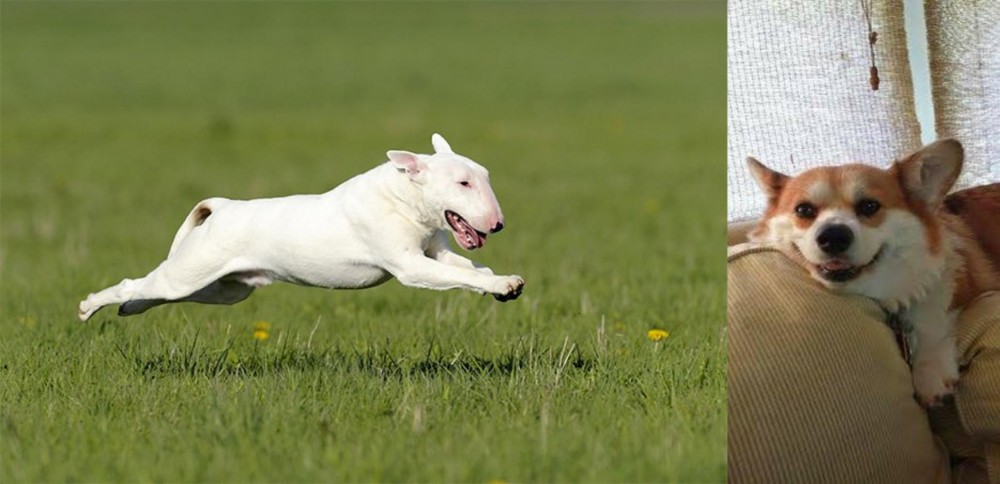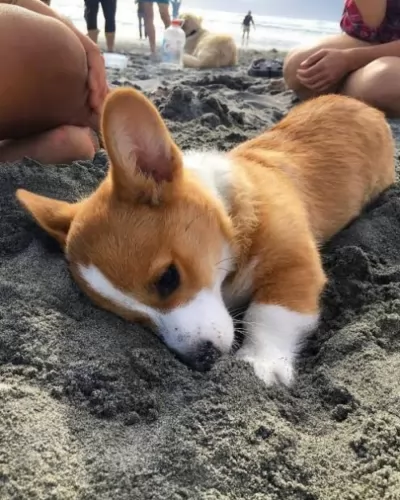 Petzlover
Petzlover Both Bull Terrier and Pembroke Welsh Corgi are originated from United Kingdom. Bull Terrier may grow 31 cm / 13 inches higher than Pembroke Welsh Corgi. Bull Terrier may weigh 15 kg / 34 pounds more than Pembroke Welsh Corgi. Both Bull Terrier and Pembroke Welsh Corgi has almost same life span. Bull Terrier may have more litter size than Pembroke Welsh Corgi. Bull Terrier requires Low Maintenance. But Pembroke Welsh Corgi requires Moderate Maintenance
Both Bull Terrier and Pembroke Welsh Corgi are originated from United Kingdom. Bull Terrier may grow 31 cm / 13 inches higher than Pembroke Welsh Corgi. Bull Terrier may weigh 15 kg / 34 pounds more than Pembroke Welsh Corgi. Both Bull Terrier and Pembroke Welsh Corgi has almost same life span. Bull Terrier may have more litter size than Pembroke Welsh Corgi. Bull Terrier requires Low Maintenance. But Pembroke Welsh Corgi requires Moderate Maintenance
 The Bull Terrier belongs to the Terrier group of dogs and this already tell you that he is highly energetic and that he is essentially intolerant of other pets.
The Bull Terrier belongs to the Terrier group of dogs and this already tell you that he is highly energetic and that he is essentially intolerant of other pets.
They are hunters by nature. The Bull Terrier is known as the Gladiator of the canine world. This breed came about through English breeders of the late 19th century, crossing old fighting dogs which carried Bulldog blood with Terriers. It was in the 1850s that James Hinks of Birmingham in the West Midlands was the first person to standardise breed type for the Bull Terrier. Hinks wanted his dogs to be white, and breeding was designed to achieve this.
Because of medical problems with the all-white dogs, Ted Lyon introduced color, using the Staffordshire Bull Terrier, and these became a separate variety. It is however, the white strain that is famous for pets as well as for show purposes.
 The Pembroke Welsh Corgi is known as an achondroplastic, a dwarf breed, and they come from Pembrokeshire in Wales. Not much is known of the dog's history but it is believed that the dogs came over with Flemish weavers who settled in Pembrokeshire way back in the 12th century already.
The Pembroke Welsh Corgi is known as an achondroplastic, a dwarf breed, and they come from Pembrokeshire in Wales. Not much is known of the dog's history but it is believed that the dogs came over with Flemish weavers who settled in Pembrokeshire way back in the 12th century already.
This dog breed has always been a cattle herding dog. Their fame has come from them being a favorite dog breed for the British royals and particularly of Queen Elizabeth II.
 The Bull Terrier is a strongly built, muscular dog with a distinctive egg-shaped head. The height of this dog is roughly 53 – 61cm and he weighs in at about 24 – 29kg. He has a short, dense coat which comes in different colors such as white, red, fawn and white or brindle.
The Bull Terrier is a strongly built, muscular dog with a distinctive egg-shaped head. The height of this dog is roughly 53 – 61cm and he weighs in at about 24 – 29kg. He has a short, dense coat which comes in different colors such as white, red, fawn and white or brindle.
The ears are medium sized and erect and the eyes are pig-like, small and dark. The medium length tail is carried slightly upwards.
The Bull Terrier is a determined, strong-willed, stubborn dog and he will require firm handling and training. With socialization and training, he becomes a friendly, loving dog who is good around children.
He tends to be possessive with his human family and their territory, making him aggressive with other pets. Bull Terriers actually have even temperaments and they are good, social dogs with people. He is courageous, brave, full of spirit and character.
 The Pembroke Welsh stands at between 25 and 30cm in height and weighs between 11 and 14kg.
The Pembroke Welsh stands at between 25 and 30cm in height and weighs between 11 and 14kg.
The coat is thick and shortish and can be fawn or a mix of colors such as white, cream, tan and black. The coat sheds quite a bit. Some of these dogs are born with their tail naturally short while others have the tail docked to give it that distinct look.
Pembroke Welsh Corgis are loving dogs and with their human families, they want to become involved with their lives. They like to please their owners and are therefore easy to train and socialize, becoming very obedient and amicable.
They’re alert, intelligent dogs and make great watchdogs too. They get on well with other pets in the home as well as children.
 The way people bring their dogs up has a lot to do with the way they turn out. The Bull Terrier has often been thought to be a dangerous dog, but this is because of a bad upbringing.
The way people bring their dogs up has a lot to do with the way they turn out. The Bull Terrier has often been thought to be a dangerous dog, but this is because of a bad upbringing.
A dog like the Bull Terrier who has received firm, fair and loving training is an absolute pleasure to have as a pet. Yes, he is a strong willed, stubborn and intelligent dog and he has the make-up to turn out to be a handful. It is perhaps why he isn't the best choice for first-time dog owners who aren’t familiar with the breed and who don’t raise him the right way.
If you choose a Bull Terrier, bring him up correctly, have him trained and socialized and never neglect him and he is guaranteed to become a wonderful, loving family member.
 British royalty has always loved the Pembroke Welsh Corgi and why not? He is loving, energetic, feisty, gentle, calm, friendly and intelligent.
British royalty has always loved the Pembroke Welsh Corgi and why not? He is loving, energetic, feisty, gentle, calm, friendly and intelligent.
Able to adapt to life in the city or the countryside, he will however need to be exercised every day as he has always been a herding- and working dog, used to working.
If you’re willing to bring the Pembroke Welsh Corgi into your home, he’ll show you what a splendid pet and companion he can be for you too.
 Your Bull Terrier is a robust breed, but there are some health issues that you will want to be aware of. For instance, the white Bull Terrier is more prone to deafness than the Brindle or tri-colored Bull Terriers. With good food and lots of love and care, he can reach 14 years of age. However there are one or two ailments what you want to be aware of.
Your Bull Terrier is a robust breed, but there are some health issues that you will want to be aware of. For instance, the white Bull Terrier is more prone to deafness than the Brindle or tri-colored Bull Terriers. With good food and lots of love and care, he can reach 14 years of age. However there are one or two ailments what you want to be aware of.
This is a common orthopedic condition with dogs, affecting both knees and resulting in loss of function and discomfort. Patellar luxation can sometimes come from a traumatic injury to the knee. However, with non-traumatic patellar luxation, the femoral groove for the knee cap is shallow or absent.
Not every variety of skin cancer in dogs is caused by sun exposure, but sun damage to the skin of the pure white Bull Terrier can be a factor. Dogs with white coats are more susceptible to sun damage. Speak to your vet about symptoms so that a physical examination will reveal the reason for sores on the skin.
 Pembrokes can live to be between 12 to 15 years. With good care they can live to be a ripe old age, but just like with any other dog, they can become ill with any of the many common dog illnesses there are.
Pembrokes can live to be between 12 to 15 years. With good care they can live to be a ripe old age, but just like with any other dog, they can become ill with any of the many common dog illnesses there are.
Some of these diseases are hip dysplasia, monorchidism and degenerative myelopathy. Being a small or short dog, they are also prone to obesity.
This is a condition where only one testicle descends and the other isn’t able to descend into the scrotum. Both testicles should be in the scrotum by 2 months of age. Monorchidism is usually genetic and you may find your dog licking his genital area quite a bit.
If you suspect your dog has monorchidism, you will need to make an appointment with your veterinarian.
This is a progressive disease of the spinal cord and is usually seen in older dogs, starting with your dog losing coordination in the hind limbs.You’ll notice your dog dragging his feet.
As the disease progresses, the limbs weaken and the dog even has difficulty with standing. Eventually the dog is unable to walk. With time your pet even suffers with urinary and fecal incontinence. Fortunately it isn’t a painful disease but you will want to speak to your vet for advice.
 The Bull Terrier is a stocky, robust breed and he will need plenty of exercise. He thrives on a good run, long walks and ball games. He is notoriously destructive, so you need to recognize this before you buy such a dog, because simply putting one in your back-yard and ignoring him will make him aggressive and destructive. This is a dog that needs lots of physical as well as mental exercise.
The Bull Terrier is a stocky, robust breed and he will need plenty of exercise. He thrives on a good run, long walks and ball games. He is notoriously destructive, so you need to recognize this before you buy such a dog, because simply putting one in your back-yard and ignoring him will make him aggressive and destructive. This is a dog that needs lots of physical as well as mental exercise.
With the short coat, Bull Terriers are easy to groom, and a brushing twice a week will keep the coat in tip top condition. He will also love the time you spend with him. Shedding of hair with the Bull Terrier is more frequent in the Spring and Fall.
Nail clipping and brushing of teeth are two other grooming routines for your dog. Remember that with teeth brushing, don’t be tempted to use human toothpaste as this can be toxic for your pet. Speak to your vet if in any doubt about how to brush your pet’s teeth.
 If you bring a puppy home, make sure he gets his puppy vaccines at 8 weeks of age.
If you bring a puppy home, make sure he gets his puppy vaccines at 8 weeks of age.
Your puppy requires 4 meals a day. Make sure to always give your pet the best quality food there is to ensure his health. Avoid giving him spicy, human food. Dogs like simple, consistent diets which don’t upset the stomach. If you buy him commercially manufactured food, buy the best quality one that isn’t full of preservatives, colorants and fillers. Try and mix in some homemade food occasionally such as chopped up boiled chicken, brown rice or pasta and some cooked vegetables such as sweet potato, spinach and carrots. A little bit of raw meat occasionally will do wonders for your pet and he will have more energy, a shinier coat, less skin allergies and less inflammation.
Always ensure your pet has a constant supply of fresh, cool water.
Brush the Pembroke Welsh Corgi’s hair twice a week. Feel for any unusual lumps while doing this. Check inside and outside his ears for ticks and fleas and ear infections.
Trim his nails.
Make sure if he goes outside that he has a shady spot to lie down in.
Exercise him. Take him on walks.
Give him your love and attention.
Take him to the vet when you can see that he is sick.
Have your dog spayed or neutered if you don’t intend for it to have puppies.